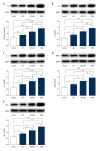The Expression and Clinical Significance of Spleen Tyrosine Kinase in Patients with Coronary Heart Disease
- PMID: 30898992
- PMCID: PMC6441303
- DOI: 10.12659/MSM.913543
The Expression and Clinical Significance of Spleen Tyrosine Kinase in Patients with Coronary Heart Disease
Abstract
BACKGROUND Our research was designed to investigate the relationship of spleen tyrosine kinase (Syk) and inflammatory factors with coronary heart disease (CHD) and the risk factors of CHD. MATERIAL AND METHODS In our study, 226 patients were enrolled, from October 2017 to March 2018. Clinical and biochemical data were collected. We collected samples of peripheral blood monocytes (PBMs) from the enrolled patients. The patients were divided in 4 groups: patients without coronary artery disease (control group), patients with stable angina pectoris (SAP group), patients with non-ST-segment elevation acute coronary syndrome (NSTE-ACS group), and patients with ST-segment elevation acute myocardial infarction group (STEMI group). We detect the protein levels of Syk and inflammatory factors expression by western blot. RESULTS Our results found the protein levels of Syk and inflammatory factors expression in the NSTE-ACS and STEMI groups were higher than those in the SAP and control groups. The protein levels of Syk and inflammatory factors expression in the SAP group were higher than those in the control group. Moreover, there were many risk factors significantly associated with Syk. Besides that, these risk factors were also independent risk factors of CHD. CONCLUSIONS Our results found that the level of Syk was associated with the severity of CHD. From our study, we found that higher levels of Syk and inflammatory factors protein were associated with worse results of the CHD. For the first time, Syk was reported to be a promising therapeutic factor for CHD patients.
Figures


Similar articles
-
miR-941 as a promising biomarker for acute coronary syndrome.BMC Cardiovasc Disord. 2017 Aug 22;17(1):227. doi: 10.1186/s12872-017-0653-8. BMC Cardiovasc Disord. 2017. PMID: 28830367 Free PMC article.
-
IL-37 increased in patients with acute coronary syndrome and associated with a worse clinical outcome after ST-segment elevation acute myocardial infarction.Clin Chim Acta. 2017 May;468:140-144. doi: 10.1016/j.cca.2017.02.017. Epub 2017 Feb 24. Clin Chim Acta. 2017. PMID: 28237549
-
Risk and timing of recurrent ischemic events among patients with stable ischemic heart disease, non-ST-segment elevation acute coronary syndrome, and ST-segment elevation myocardial infarction.Am Heart J. 2016 May;175:56-65. doi: 10.1016/j.ahj.2016.01.021. Epub 2016 Feb 23. Am Heart J. 2016. PMID: 27179724 Clinical Trial.
-
Lower AMP-activated protein kinase level is associated with the vulnerability of coronary atherosclerotic plaques by attenuating the expression of monocyte autophagy.Coron Artery Dis. 2015 Jun;26(4):322-7. doi: 10.1097/MCA.0000000000000243. Coron Artery Dis. 2015. PMID: 25768243
-
API expert consensus document on management of ischemic heart disease.J Assoc Physicians India. 2006 Jun;54:469-80. J Assoc Physicians India. 2006. PMID: 16909697 Review.
Cited by
-
1H-NMR-based metabolomics study on coronary heart disease with blood-stasis syndrome and phlegm syndrome.Zhong Nan Da Xue Xue Bao Yi Xue Ban. 2021 Jun 28;46(6):591-600. doi: 10.11817/j.issn.1672-7347.2021.190172. Zhong Nan Da Xue Xue Bao Yi Xue Ban. 2021. PMID: 34275927 Free PMC article. Chinese, English.
-
Identification of biomarkers associated with phagocytosis regulatory factors in coronary artery disease using machine learning and network analysis.Mamm Genome. 2025 Jun;36(2):601-613. doi: 10.1007/s00335-025-10111-5. Epub 2025 Feb 14. Mamm Genome. 2025. PMID: 39953122 Free PMC article.
-
Spleen tyrosine kinase (SYK) signals are implicated in cardio-cerebrovascular diseases.Heliyon. 2023 Apr 22;9(5):e15625. doi: 10.1016/j.heliyon.2023.e15625. eCollection 2023 May. Heliyon. 2023. PMID: 37180910 Free PMC article. Review.
-
Integrated identification of key immune related genes and patterns of immune infiltration in calcified aortic valvular disease: A network based meta-analysis.Front Genet. 2022 Sep 21;13:971808. doi: 10.3389/fgene.2022.971808. eCollection 2022. Front Genet. 2022. PMID: 36212153 Free PMC article.
-
Histone methyltransferase DOT1L mediates the TGF-β1/Smad3 signaling pathway through epigenetic modification of SYK in myocardial infarction.Hum Cell. 2022 Jan;35(1):98-110. doi: 10.1007/s13577-021-00625-w. Epub 2021 Oct 11. Hum Cell. 2022. PMID: 34635982
References
-
- Tanaka K, Sata M. [Atherosclerosis: Progress in diagnosis and treatments. Topics: II. Atherosclerosis – promoting factors; Pathogenesis and pathophysiology; 3. From basic research: focusing on large and peripheral vessels]. Nihon Naika Gakkai Zasshi. 2013;102:305–12. [in Japanese] - PubMed
-
- Plasschaert H, Heeneman S, Daemen MJ. Progression in atherosclerosis: Histological features and pathophysiology of atherosclerotic lesions. Top Magn Reson Imaging. 2009;20:227–37. - PubMed
-
- Vanhoutte PM, Shimokawa H, Feletou M, Tang EHC. Endothelial dysfunction and vascular disease – a 30th anniversary update. Acta Physiologica (Oxford, England) 2017;219:22–96. - PubMed
MeSH terms
Substances
LinkOut - more resources
Full Text Sources
Miscellaneous

